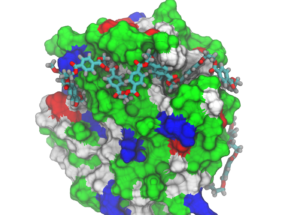Biodegradable polymers – Current outlook and future prospects
Biodegradable polymers, the latest science, and addressing the challenges of bioplastics. Download a PDF copy of the presentations given at the Symposium here:
- CSIRO-Murdoch University Industry Bioplastics Innovation Hub – Daniel Murphy (Murdoch University)
The CSIRO-Murdoch University-Industry Bioplastics Innovation Hub is focused on developing compostable plastics that leave no lasting plastic legacy on land and in water. A major component of this project is to decrease bioplastic production costs through utilising innovative bioreactor carbon feedstock sources and the simultaneous production of high-value microbial biopolymers that create new commercial opportunities. Expected benefits include cheaper bioplastic resin chemistries and diversifying bioplastic product lines to de-risk commercial uptake of a bioplastics economy. Since compostable plastics are made from renewable resources, including food wastes, they provide significant economic, environmental and health benefits to the Australian community, now and for generations to come.
Plastic pollution has become a major environmental challenge that threatens the health and well-being of our planet. Biodegradable plastics have been hailed as a potential solution to this problem, as they promise to break down into harmless materials after use. However, the effectiveness of biodegradable plastics in reducing plastic waste is still a matter of debate. This presentation examines the potential of biodegradable plastics as a solution to plastic waste, detailing why they are necessary and addresses their limitations. We will also provide some valuable insights and highlight some of the strategic and commercial work that CSIRO are doing to improve the performance of biodegradable plastics for greater uptake, to ultimately reduce plastic waste in the environment.
Bioplastics are considered environmentally friendly alternatives to their fossil-based counterparts due to the renewable feedstocks used for their production. However, not all bioplastics are biodegradable, and their feedstock production competes with food crops for land, water, and nutrient sources. The use of microorganisms such as bacteria and microalgae has attracted increasing attention for bioplastics production. Microalgae are photosynthetic, do not need arable land for mass cultivation, have higher growth rates than conventional crops, and can be grown on wastewater or seawater. However, the major challenge associated with microalgae-based products is the economic feasibility of the process. Microalgae can be utilized in various ways to produce bioplastics. The most economically viable pathway to produce algal bioplastics can be identified by technoeconomic analysis. Furthermore, a decision-making tool based on technoeconomic framework can inform research and development efforts and direct the industry towards optimizing the right process and parameters for successful commercialization of algal bioplastics.
- Replacing plastic with ocean-derived materials [not available for download – please contact speaker] – Julia Reisser(Uluu)
Uluu is a Western Australian start-up developing ocean-derived materials capable of replacing plastic at scale, while tackling climate change and improving the health of our seas. We produce a plastic alternative known as polyhydroxyalkanoate; or PHA for short. This material is naturally produced and truly biodegradable; just like cotton, silk and paper. What makes this natural material stand out from others, is its capacity of mimicking plastic properties really well – it repels water, it’s lightweight and durable. We use farmed seaweed (rather than fossil fuels, terrestrial crops or waste) as a carbon source to produce our PHA. Doing so provides us with the unique potential to sustainably scale enough carbon to decouple our polymer economy from fossil fuels. A significant barrier for PHA adoption is cost. At Uluu, we believe that by combining seaweed, seawater and saltwater microbes to produce PHA, we will reach cost parity with plastic. For instance, our unique saltwater fermentation process reduces the need for costly chemicals and the energy-intensive, slow equipment sterilisation processes others perform. Uluu’s prospective customers include brands and manufacturers reliant on plastic to sell their products. Rather than purchasing plastic pellets produced by petrochemical companies, they can now purchase Uluu pellets instead – a move that will support a plastic-free future.
Plastics such as polyesters can take centuries to biodegrade in landfills or water bodies, but some organisms in nature are slowly evolving to degrade plastic waste in their environments. Bioplastics can be more susceptible to biodegradation, with the benefit of lower net carbon emissions as they are produced from renewable plant materials. Plastic degrading enzymes produced by such organisms can be repurposed for potential industrial applications, including chemical recycling in a circular economy, environmental remediation, and designing easily biodegradable plastics. However, natural enzymes are often not optimal for industrial use due to their limited activity efficiency and thermal tolerance. By data mining genomic information from microorganisms living in high temperature environments, we have identified novel, highly thermal tolerant bioplastic degrading enzymes. These enzymes can be reengineered in the laboratory to optimize properties like activity by accelerating the natural enzyme evolution process, aided by emerging Machine Learning and Artificial Intelligence technologies.
Plastic waste has become one of the most prevalent subjects in the global discussion of ecology and the environment. The use of bioplastics is one emerging method to address this issue. Another is the implementation of plastic degrading enzymes. PETase from Ideonella sakaiensis 201-F6 is an esterase capable of degrading the conventional plastic polyethylene terephthalate (PET). Lip1 is an intracellular lipase from Pseudomonas chlororaphis PA23 capable of degrading several types of bioplastics, including polyhydroxyalkanoates (PHA), polycaprolactone (PCL), polylactic acid (PLA), and polyethylene succinate (PES). A combination of artificial intelligence, ancestral sequence reconstruction5, and rational protein engineering has been used to increase the thermostability and activity of these enzymes. Here we describe the crystal structure of the improved enzymes and highlight the importance of the engineered mutations for the development of a circular economy.

